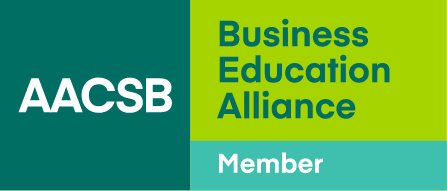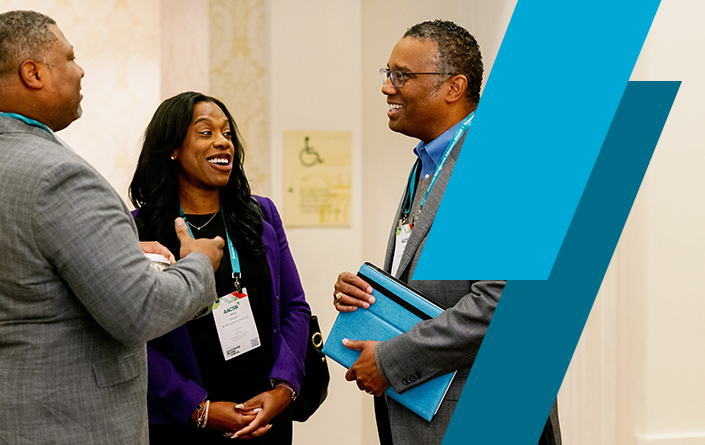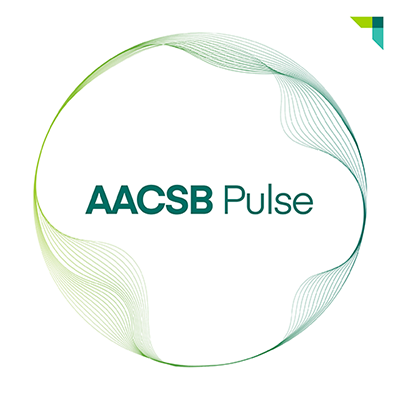An MBA Reimagined From the Ground Up
- Manchester Metropolitan’s new HyFlex approach suits the needs of diverse learners, covers critical current topics such as AI, and emphasizes real-world connections.
- Induction sessions not only provide students with practical knowledge, but also build community and promote a love of learning.
- To help students thrive in their careers, the program offers leadership training that includes coaching, mentoring, and explorations of each individual’s strengths and weaknesses.
As the business world evolves, business schools must constantly adapt. At Manchester Metropolitan University in the United Kingdom, we knew we had to embrace adaptability when we set out to reimagine our MBA program in 2023.
We had many goals we wanted to meet with our revised MBA. First, after almost 30 years of delivering either face-to-face or online programs, we looked for a new balance between the two modes of delivery. We adopted a hybrid and flexible (HyFlex) approach that enables high interactivity and co-learning between remote and in-class students. This approach allowed us to meet the needs of diverse cohorts, including neurodivergent learners and students with caring responsibilities.
Second, we wanted the revised curriculum to reflect critical aspects of the modern business world, including the emergence of artificial intelligence technology and the urgent need for responsible leadership. Third, we ensured we maintained our ties to industry through strong partnerships and ongoing research.
Finally, we wanted to create an MBA where the student experience was at the heart of the program, supported by updated academic offerings and tailored student services.
We set ourselves an ambitious target of finalizing the transformation by September 2024, which gave us 12 months to deliver the new program. While the effort was not a smooth or linear one, it set us on an exciting journey.
The ABCs of Redesign
To launch the new program, we separated the work into three streams: the academic curriculum, the professional services and wraparound support, and the HyFlex technology needed to deliver the new MBA. For each stream, we took a bottom-up approach. We asked teams to imagine how they could fulfill their roles in ways that not only met the needs of future MBA students, but also were unique to the Manchester Met University Business School.
We discovered that, to develop a new MBA from the ground up, we needed to follow the ABCs of agility, buy-in, and collaboration.
Agility. During the first year, we operated as a startup unit both within the business school and the university. Drawing outside the lines became our modus operandi. We were constantly juggling deadlines to get all the moving pieces in the right place at the right time, and more often than not we employed the trial-and-error method as we tried to figure out our next steps.
We had, albeit for a limited time, the luxury of developing some bespoke practices and policies as we refined the new program. We had to develop the ability to tolerate uncertainty, because we weren’t sure the new MBA would look as good in practice as it did on paper.
During the first year, we operated as a startup unit both within the business school and the university, developing bespoke practices and policies as we refined the program.
Buy-in from senior management. Due to the strategic importance of the new MBA, we received a great deal of support from key stakeholders across the university. Senior leadership made a significant investment of resources in the new MBA and temporarily excused us from adhering to organizational structures, processes, and deadlines.
For example, we did not follow the university’s specific and time-consuming process for approving academic programs and their fees by going through multiple steps and committees. Instead, we often made rapid decisions based on the chair’s input. We also created a bespoke student payment approach solely for the MBA.
Senior leaders placed their trust in our team despite knowing that the learning curve was steep and that we would not reap the fruits of our labor immediately. This support equipped us with the resources, confidence, and space we needed to design and deliver the new MBA in such short period of time.
Collaboration. Collaborations occurred on many levels and in many contexts to enable us to move quickly from inception to execution.
First, we asked academics across the five departments in the business school to contribute insights drawn from their own research and industry connections. This approach gave every team a voice and reduced resistance to change and tight deadlines. By working together, we were able to produce an MBA curriculum that was informed by research, led by practice, aligned with the United Nations Sustainable Development Goals, and assessed in innovative ways. We also were able to meet requirements from multiple accreditation bodies and avoid overlaps in content.
Second, we encouraged faculty to use their professional networks to enhance the learning experience. All of them invited guest speakers to appear in the classroom, and some also drew on their own industry experience to enrich their teaching. In addition, we obtained industry input by maintaining open communications with local business partners such as the Greater Manchester Chamber of Commerce and the Greater Manchester Good Employment Charter.
Third, we formed a cross-functional team composed of academics as well as colleagues from the estate management team and the department of information technology and digitalization. This group created the MBA HyFlex suite and did project managing for the space and the delivery of the equipment.
Finally, we worked with colleagues from marketing and recruitment, student services, career services, alumni relations, and the library to develop customized processes and provisions to meet the needs of MBA students.
Delivery Basics
To create the HyFlex suite, we transformed a normal classroom through the use of Microsoft Teams Rooms (MTR) technology, cutting-edge cameras, microphones, and screens. In this setting, in-class students perceive the remote ones as if they are all in class together, while remote students can perfectly see instructors moving around the room and easily interact with their peers. If they choose to at a later date, students can revisit recordings of classroom sessions that take place in the virtual learning environment.
In addition, we have transformed a second space where we have installed soundproof pods. In this space, blended teams of in-class and remote students can work together on case studies, simulations, and role-playing activities.
The induction session introduces students to the ethos of the MBA program. It is designed to instill a sense of belonging and pride in students and cultivate in them a yearning for lifelong learning.
As part of finding the right balance between online and face-to-face delivery, we asked, “Why not change the way students can attend the class?” We turned to our Centre for Learning Enhancement and Educational Development (LEED) for support in adapting our approach to teaching and learning. Our LEED colleagues trained the academic team and developed bespoke virtual learning environments and learning models.
As an example, our new 3C model is built around the ideas of “concept, curate, collaborate.” Through this approach, students can complete asynchronous learning assignments before attending the synchronous parts of the module, where they process their understanding of course topics and work with peers to enhance their learning experience.
We also revisited basic elements of the program, such as our induction sessions. Induction is the first point of socialization in a HyFlex model, so all students are expected to attend in person. During the induction, we cover both technical and aspirational aspects of the MBA. Students not only learn the structure of the program but also receive AI training to enhance their knowledge of the technology and enable them to use AI responsibly during their studies.
Just as important, the induction session introduces students to the ethos of the MBA program, thus setting clear behavior expectations. It is designed to instill a sense of belonging and pride in students and cultivate in them a yearning for lifelong learning. To encourage them to place their trust in the educational process, we bring in alumni to share what it was like for them as they pursued their MBAs and to offer guidance on how students might make it through the program even when they are feeling stuck.
We also use this time to create a sense of community through team-building exercises. For the first two cohorts, we ran a chocolate-making session organized by a small-business owner. During these events, students not only had fun, but also learned about the entrepreneurial and leadership journey of the company owner.
In another exercise, we brought in colleagues from the School of Art to introduce business students to the concepts of design thinking for innovation. What was fascinating to us was that students remembered these design thinking theories and used them in later assignments.
New and Improved Opportunities
In addition to redesigned course delivery and induction activities, our MBA includes revised content and new opportunities.
During the two years of the program, students complete two major projects. The first one is an applied entrepreneurship project that is part of the Transformational Applied Entrepreneurship module. This module promotes societal impact by encouraging students to use the entrepreneurial cycle to tackle grand societal challenges such as ensuring responsible use of AI or reducing inequalities in education. The second project, Consultancy in Action, gives students a chance to work with real-world clients and hone the skills they will need if they start their own consultancy companies.
We focus on the leadership journey by helping students understand their own skills and unrealized strengths.
Students also have the opportunity to participate in a study abroad trip. During the module on Global Economic Change and Business, students can reflect on the lessons they learned during this international activity.
Another key part of the revamped curriculum is our focus on the leadership journey students will take as they advance in their careers:
- We use the Cappfinity Leader Strengths Profile, which is introduced during the induction, to help students understand their own skills and unrealized strengths. Students bring their results with them when they meet with personal tutors and career coaches. They are expected to use the results during various reflection assessments, such as the one they undertake in the module on Developing Leadership for Decent Employment and Productivity. We expect students to refer to their strengths profiles as they reflect on the changes they have made to their leadership styles throughout their MBA journeys.
- We provide students with executive career coaches who can share insights from their longtime industry experience. In addition, the central career office’s team encourages students to contemplate their own stories and consider how their networks and ecosystems of connections can help them reach their goals.
- We have introduced the MBA Alumni Mentoring Scheme in which alumni share with current students how they managed to balance their careers, studies, and personal lives. These interactions also provide networking opportunities.
A Commitment to Change
The biggest secret to our success is that we are not done. Every day, with every interaction and piece of feedback we get, we are still learning. We are dedicated to continuous development.
As the ancient Greek philosopher Heraclitus said, “The only constant in life is change.” Because that’s definitely true in the business world, it must also be true for management education. We can never stop evolving.






